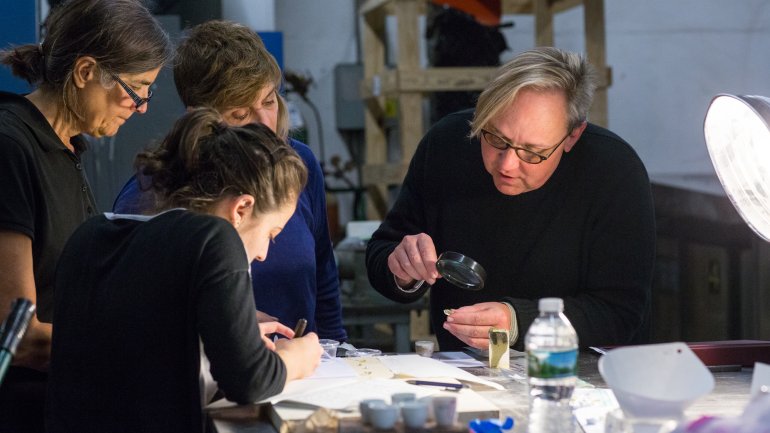Yearlong RISD Glass Celebration Concludes
In 1966, the American studio glass movement was only a few years old. That year, Norm Schulman, then head of ceramics at Rhode Island School of Design, asked himself a bold question: What if he had students help him set up kilns and furnaces in a building on a colleague’s farm off campus and started RISD’s inquiry into glass? He proceeded to do just that.
The inquiry soon outgrew the farm and moved to the heart of RISD’s city campus, becoming an actual program under the remarkable stewardship of Dale Chihuly. And this autumn, RISD will conclude a year’s worth of festivities in celebration of the 50th anniversary of that program’s inception – festivities that have included lectures, Hotnights (demonstrations and workshops in the hot shop), and the publication of the book Wonder: 50 Years RISD Glass. Artists who have been or are still a part of RISD’s glass program, including Chihuly, Toots Zynsky, Jamie Carpenter, and Michael Glancy – and younger up-and-comers such as Tavares Strachan, Helen Lee, Alex Rosenberg, Doreen Garner, and Matt Szösz – are among the art and design world’s most creative and feted. And in their work, all of them echo the spirit of experimentation and investigation that characterized that original question, What if…?
In their own ways, they have, through the years, made experimentation their byword. They’ve heard criticism for venturing far, far beyond the realm of glass as craft, but they would not have it any other way. From the beginning, they have seen glass as a wondrous substance that can tell a story or express a concept in untold ways. Dale Chihuly’s glass outdoor sculptures blaze with color, fluidity and life, like botanical wonders. Tavares Strachan creates installations out of glass to spur cultural change by exploring the themes of distance and belonging – being visibly invisible. In Jamie Carpenter’s work, glass is used in architecture to reflect a landscape or create a luminous waterfall, or in some other way to “reawaken people’s engagement with nature,” as he described to one RISD audience this year. Toots Zynsky has used glass to express concepts in video performance art (not to mention helping to develop a machine that allows her to create pieces made from thousands of delicate colored glass threads, a technique she calls filet de verre.)

An installation by Yidan Zeng and Saba Yazdjerdi created in Synthesis of Light a recent interdisciplinary studio co-taught by glass critic Stefanie Pender and visiting designer James Carpenter. Photo: Jo Sittenfeld
From the beginning, RISD glass artists have also championed a multi-disciplinary, collaborative spirit. Chihuly, back in the early days, brought in visiting artists, and all kinds of experts have passed through the doors since. “Glass requires it,” says Rachel Berwick, an installation artist and head of the department. What’s more, she notes, research and investigation are the “foundation of the creative process.”
A perfect example of all of this, which took place during this past year’s festivities, was the Alchemy Project. For that, Columbia University historian Pamela Smith and the team from the Making and Knowing Project gathered at RISD with glass faculty and students, and scientists and curators from around the world to try to help Berwick and others recreate a recipe, found in an anonymous 16th-century manuscript, for making gold ruby glass – down to recreating the charcoal used for the furnace 500 years ago. Did they make the gem? No, says Berwick, though they did get “a gorgeous tinge of gold and green in the glass.” Not knowing what would happen energized them, she notes: RISD glass artists think of themselves as problem “finders” as well as problem solvers. Perhaps 50 years from now, when RISD Glass celebrates 100 years of existence, its artists will have solved the puzzle and made the alchemical gem. As for what else they will have created with glass by then, well, here’s to the future, whatever it will be.

